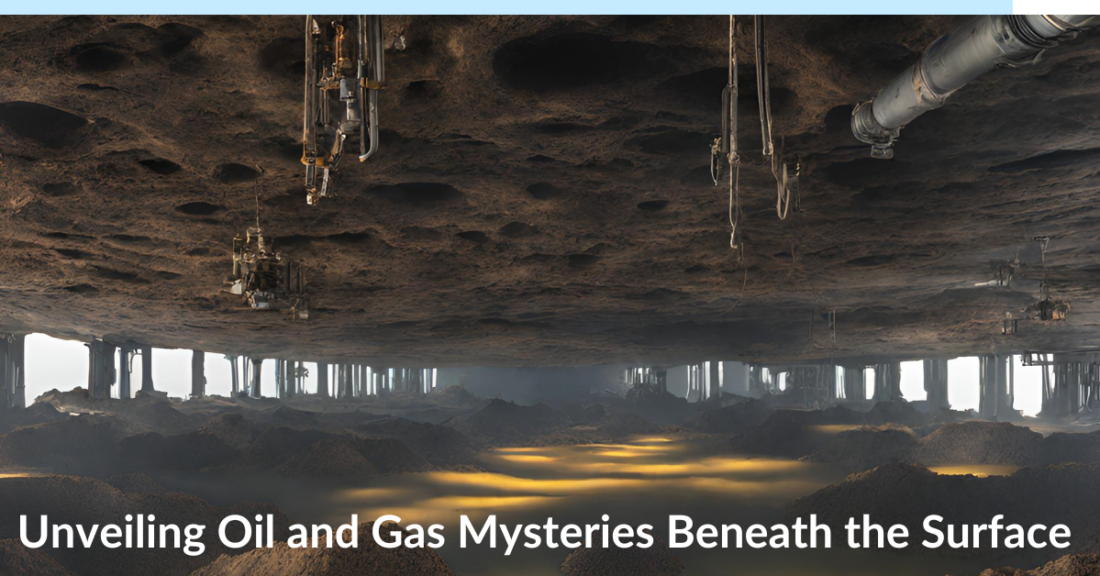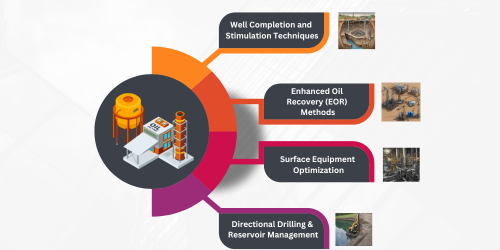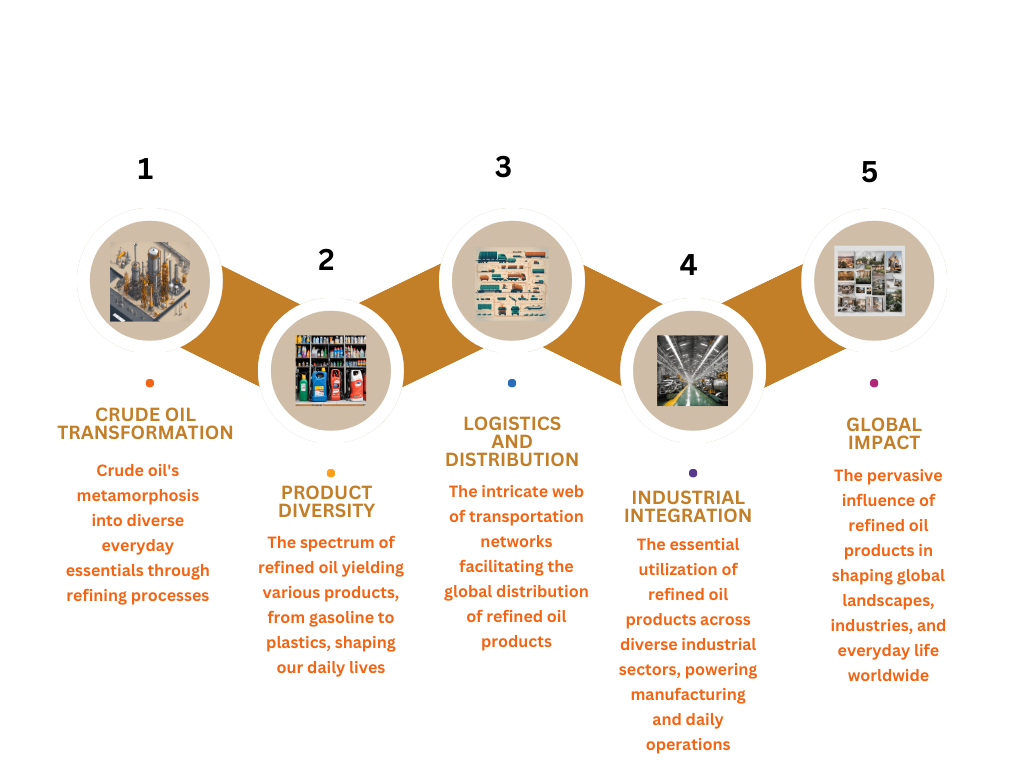Unveiling the Depths: Oil and Gas Exploration
Reservoir characterization and evaluation are like detective work for oil and gas. They’re all about figuring out how much oil or gas is hiding underground and how easy it is to get it out.
- Porosity: It’s like counting the holes in a sponge. More holes mean more room for oil or gas to hang out.
- Permeability: Imagine a sponge that lets water flow easily. Rocks with high permeability allow oil or gas to move through them easily.
- Reserve Estimation: It’s like guessing how much cake you can make with the ingredients you have. Engineers use lots of data to estimate how much oil or gas is down there.
To figure this out, engineers use tools that measure rocks while drilling (like taking pictures of the inside of the Earth) and even grab pieces of rock (cores) to study in labs. All this detective work helps them decide the best way to get the oil or gas out while making sure it’s worth the effort and cost.
Flowing Forward: Production Operations
- Well Completion and Stimulation Techniques: It involves ensuring the wells are in top shape and employing methods like hydraulic fracturing or acidizing to enhance oil or gas extraction from underground rocks. It’s akin to providing a power boost to wells for increased production.
- Enhanced Oil Recovery (EOR) Methods: Once the easy-to-reach oil is extracted, engineers utilize heat, chemicals, gases, or advanced techniques to extract more oil that remains trapped. It’s comparable to using specialized tools to squeeze out the last bits of toothpaste from a tube.
- Surface Equipment Optimization: This focuses on maintaining and optimizing the machines and gadgets above ground, ensuring they function flawlessly to process the oil or gas obtained from wells. It’s like fine-tuning a factory to maximize the output of what’s being produced.
- Directional Drilling and Reservoir Management: Utilizing advanced drilling techniques to navigate underground, accessing specific zones efficiently. Alongside, reservoir management strategies involve maintaining optimal pressure and temperature conditions underground for prolonged efficient production.
In short, these steps are about making sure the wells work well, getting the most oil or gas out of them, and making everything above ground run as efficiently as possible.
Fig title- Streamlining Oil & Gas Production: Processes & Precision
Refined Innovations: Downstream Processes
The world of oil and gas doesn’t just stop at drilling and extraction. Once crude oil is brought to the surface, a fascinating journey begins – a journey through downstream processes. This phase is where the raw material, crude oil, undergoes a transformation into the everyday products we use. It’s a captivating story of refinement, innovation, and logistics that shapes the items we rely on in our daily lives.
The downstream sector involves a series of intricate steps that refine crude oil into valuable products. It’s like a complex recipe in a grand kitchen, where crude oil is processed through various techniques and technologies to create gasoline, diesel, jet fuel, and an array of materials we encounter in our homes and industries. But it’s not just about making fuel; it’s also about unlocking the potential of the by-products to create plastics, lubricants, and other essential components.
Furthermore, this journey doesn’t end at production. It’s equally about ensuring these products reach their destinations efficiently and effectively. This involves a web of distribution channels, storage facilities, and transportation networks that keep the flow of these refined products seamless, reaching consumers and industries worldwide. The downstream sector represents the inventive and logistical side of the oil and gas industry, shaping the materials that power our lives and drive various sectors of the global economy.
Refining turns crude oil into different useful things, like gasoline and plastics, using methods similar to cooking. After making fuel, leftover parts are used to create everyday items like toys and car parts, making the most out of every bit. Then, big trucks, trains, and pipelines step in to smoothly move these products to stores and homes, just like ensuring groceries reach home without any issues.
Fig- From Crude to Connectivity: The Refined Impact of Oil Across Spheres
Shifting Landscapes: Emerging Trends and Challenges
1. Renewable Energy Integration:
As the world shifts towards sustainable practices, oil and gas companies are exploring the incorporation of renewable energy sources into their operations. Companies like Shell, BP, and TotalEnergies are investing in solar and wind-powered facilities. These sources supplement traditional energy, reducing reliance on fossil fuels and mitigating environmental impact.
2. Digitalization and Automation:
Integration of technology like IoT devices and digital twins allows companies to monitor operations remotely, optimizing efficiency and safety. Chevron, ExxonMobil, and Saudi Aramco are actively implementing automation in drilling and production processes. Digitalization minimizes human error, enhances decision-making, and improves asset performance.
3. Environmental Sustainability Efforts:
Oil and gas giants such as Equinor, Eni, and Chevron are leading initiatives to reduce their carbon footprint. They’re investing in carbon capture and storage (CCS) technologies, exploring cleaner extraction methods, and actively participating in renewable energy projects. Efforts are focused on reducing emissions, minimizing waste through advanced recycling, and adopting greener technologies for a sustainable future.
Fueling Progress: The Data Revolution in Oil and Gas
Data-driven decision-making has revolutionized the oil and gas industry, enhancing efficiency, safety, and profitability. Advanced technologies like sensors, IoT devices, and data analytics gather and process immense volumes of real-time data from drilling rigs, production sites, and distribution networks. This data provides invaluable insights into equipment performance, reservoir behavior, and operational trends, enabling predictive maintenance to prevent costly breakdowns and optimize production schedules.
Moreover, machine learning algorithms and AI models analyze seismic data to pinpoint drilling locations with higher accuracy, reducing exploration risks and boosting successful discoveries. It also aids in optimizing extraction techniques, enabling engineers to adapt processes for higher yields while minimizing environmental impact.
Data-driven insights not only drive operational excellence but also guide strategic decisions, helping companies navigate market fluctuations, optimize supply chains, and invest in sustainable practices. Overall, this reliance on data empowers the industry to make informed decisions at every stage, from exploration to distribution, fostering innovation and sustainable growth.
Makoro: Empowering Oil & Gas Innovations
In the oil and gas industry, Makoro serves as a catalyst for innovation, streamlining complex processes and addressing emerging challenges.
Makoro’s Role:
- Data-Driven Efficiency: Makoro leverages AI and analytics to optimize operations, from reservoir exploration to downstream processes. It aids in real-time decision-making, reducing costs, and enhancing efficiency at every phase.
- Sustainable Solutions: Makoro enables oil and gas entities to embrace sustainability by providing insights for renewable energy integration and environmental impact mitigation. It aids in the transition toward cleaner practices and eco-friendly operations.
- Tech-Infused Operations: By facilitating digitalization and automation, Makoro aligns with industry trends. It offers tools for remote monitoring, predictive maintenance, and intelligent decision-making, aiding companies in embracing technology-driven transformations.
Explore the world of Makoro – where innovation meets excellence! Dive into our website for an exclusive inside look!




